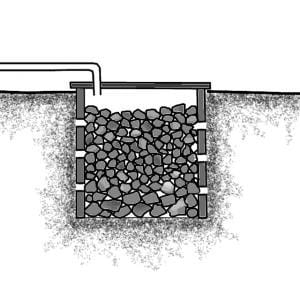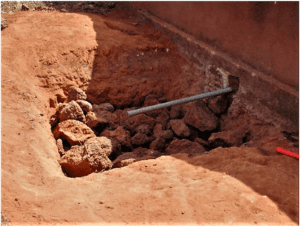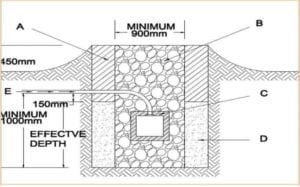Soak Pit Design. What you need to know about Soak Pit.
Soak Pit Design. What you need to know about Soak Pit.
Soak Pit Design
What is a Soak Pit? : A soak pit which is also called a soakaway is a closed porous wall chamber that is primary design to allows water to slowly soak into the ground.
The wastewater generated in the house from the kitchen and bathrooms has to be disposed of. If it is disposed of in open it not only creates unhygienic conditions, foul odors but also invites epidemics and diseases. Soak pit is ideal.
A Soak Pit is a covered, porous-walled chamber that allows water to slowly soak into the ground. Pre-settled effluent from the septic tank is discharged to the underground chamber from where it infiltrates into the surrounding soil.
Design of Soak Pit

RELATED: 10 STEPS TO OWNING A HOME IN KENYA
A layer of sand and fine gravel is spread across the bottom to help disperse the flow. Depth should be between 1.5 and 4m deep, but never less than 1.5m above the groundwater table. The Soak Pit is filled with coarse rocks and gravel. The rocks and gravel will prevent the walls from collapsing, but will still provide adequate space for the waste-water.
It should be located at a safe distance from a drinking water source, ideally more than 30 m. The soak pit should be kept away from high traffic areas so that the soil above and around it is not compacted.
How Soak Pit Design Work
As waste-water percolates through the soil from the soak pit, small particles are filtered out by the soil matrix and organics are digested by micro-organism.

Soak pit with installed PVC pipe
Soak pit is best suited to soils with good absorptive properties; clay, hard-packed or rocky soils are not appropriate.
Well-sized soak pits should last between three and five years without maintenance. To extend the life of a soak pit care should be taken to ensure that the effluent has been clarified and or filtered to prevent the excessive buildup of solids.
Particles and biomass will eventually clog the pit, and it will need to be cleaned or moved.
When the performance of the soak pit deteriorates, the material inside the soak pit could be excavated and refilled.
Adequacy
A Soak Pit does not provide adequate treatment for raw wastewater and the pit will clog quickly. A Soak Pit should be used for discharging pre-settled black water or greywater.
Soak pits are appropriate for rural and suburban settlements. They depend on soil with a sufficient absorptive capacity. They are not appropriate for areas that are prone to flooding or have high groundwater tables.
Whereas clay soils, as well as hard pack soils, are not appropriate, they could be used in almost every temperature.
Health Aspects
The technology is located underground and thus, humans and animals should have no contact with the effluent. The Soak Pit should be constructed at a distance of at least 30 m from drinking water wells in order to prevent cross-contamination. The groundwater table is a least 1.5 m below the soak Pit. The Soak Pit is odourless and not visible.

Soak Pit Schematic Diagram A-masonry ring B-stone or brick aggregate C-brick chamber D-30cm thick outer casing with coarse sand E-effluent from septic tank
FREE SEPTIC TANK DESIGN DOWNLOAD HERE
Maintenance
- the effluent should be clarified or filtered well to prevent excessive build-up of solids.
- The Soak Pit should be kept away from high-traffic areas.
- Particles and biomass will clog the pit so need to be cleaned or moved.
- For future access, a removable lid should be used to seal the pit.
Functions of Soak Pit
Wastewater from the septic tank or the biodigester is often channeled to the soak pit in order to percolates and infiltrated into the ground. Again, greywater from the kitchen channeled from the grease trapper is channeled to the septic. What then is the functions of the soak away pit?
Here are the main functions of soak pit
- The soak pit serves as a receiving container of the effluent water from the main treatment unit,
- Soak pit performs partial treatment of the wastewater coming out of the main treatment system
- Soak-pit releases clear and non-harmful water to the ground/environment
- To recharge the groundwater bodies, the soak-pit helps.
Advantages of Soak Pit
- Can be built and repaired with locally available materials.
- Small land area required.
- Can be built and maintained with locally available materials.
- A simple technique for all users.
Disadvantages of Soak pit
- Pre-treatment is required to prevent clogging, although eventual clogging is inevitable.
- Negatively affects soil and groundwater properties.
Also Read: Construction materials and current market prices
READ: 7 Tips to Cut Construction Costs (Helpful Guide)

